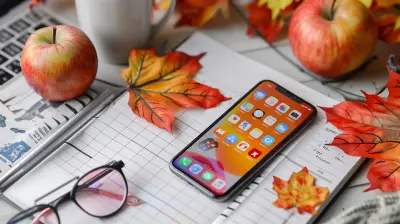Improving Communication Skills for Team Collaboration
28 October 2025
Let’s be real—communication isn’t just about talking. It’s about connecting. In team settings, whether it’s a school project, a corporate brainstorm, or a nonprofit group effort, the way we communicate sets the tone for everything. Good communication? That’s how ideas take flight and how people truly collaborate. Poor communication? Hello, misunderstandings, frustrations, and missed deadlines.
Improving communication skills for team collaboration isn’t as complicated as it sounds. In fact, it's something we can all work on with just a bit of self-awareness and practice. Ready to dive in? Let’s talk about how strong communication can turn a good team into a great one—and exactly how you can make that happen.
Why Communication Is the Backbone of Team Collaboration
Think of a team like a band. Each member plays a different instrument, but it’s the communication between the players that makes the music flow. If the drummer doesn’t know when the guitarist is jumping into a solo, the whole rhythm falls apart.Teams are the same. Without clear and open communication, even the most talented group can fumble. Communication helps:
- Share ideas openly
- Solve problems faster
- Avoid or resolve conflict
- Build trust and respect
- Keep everyone aligned and motivated
So, if you’ve ever been part of a team that felt disjointed or struggled to hit goals, communication might’ve been at the heart of it.
Signs You Might Need to Improve Communication in Your Team
Before we get into the “how,” it’s helpful to spot the warning signs. Poor team communication doesn’t always look like shouting or constant disagreement. Sometimes it’s subtler:- Silence during meetings—People aren’t speaking up.
- Repeated mistakes—Instructions are misunderstood.
- Lack of feedback—No one corrects or praises.
- Duplication of work—Two people doing the same task unknowingly.
- Low morale—People seem disengaged or frustrated.
Recognize any of these? Don’t worry—it’s fixable. Let’s get into the good stuff.
Step 1: Practice Active Listening
Here’s the thing—most of us aren’t listening to understand. We’re listening to reply.Active listening means you’re fully present and tuned in to the speaker. No distractions, no thinking about what you’ll say next. Just… listening.
How to Practice Active Listening:
- Make eye contact. It builds connection.- Nod or give verbal feedback. A simple “I see” or “That makes sense” goes a long way.
- Paraphrase what you heard. Try saying, “So, what you're saying is…” to confirm understanding.
- Don't interrupt. Let others finish completely before jumping in.
The goal? Make the speaker feel heard and understood. When everyone on the team feels that way, magic happens.
Step 2: Be Clear and Concise
Ever read a message and thought, “Wait, what?” Yeah, ambiguity is a collaboration killer.Whether you’re sending a Slack message, writing an email, or speaking in a meeting, clarity is king.
Tips for Clearer Communication:
- Get to the point. Don’t bury your main message in fluff.- Use simple language. Big words don’t make you sound smarter—clarity does.
- Stick to one topic at a time. Avoid bouncing around.
- Confirm understanding. Ask, “Does that make sense to everyone?”
Remember, if people have to decode what you’re saying, they’re using brainpower that could be going toward solving problems or coming up with brilliant ideas.
Step 3: Encourage Open Dialogue
If your team culture feels like “Don’t speak unless spoken to,” it’s time for a change.Encouraging open dialogue means making everyone feel safe to voice opinions, ask questions, and challenge ideas respectfully.
Ways to Promote Openness:
- Ask for input. Try saying, “What are your thoughts on this?” or “I’d love other perspectives.”- Praise contributions. Acknowledge when someone shares, even if you take a different direction.
- Stay curious. Ask follow-up questions to dig deeper.
- Be transparent yourself. Vulnerability builds trust.
A team that speaks up is a team that grows. You never know—your quietest team member might have the game-changing idea.
Step 4: Understand Communication Styles
Just like people have different learning styles, they also have different ways of communicating. Some are direct. Others prefer to ask lots of questions. Some like to process quietly, while others talk through their thoughts.Common Styles You Might Encounter:
- Assertive: Clear and confident. They say what they mean.- Passive: May avoid conflict or not speak up readily.
- Passive-aggressive: Appears agreeable on the surface but may express frustration indirectly.
- Aggressive: Dominates conversations, often doesn’t listen well.
Your job? Adapt. Learn to recognize these styles and adjust your approach. For example, if someone’s passive, give them space and encouragement to share. If someone’s aggressive, model calm and respectful behavior.
Step 5: Use the Right Tools for the Right Conversations
Let’s be honest—some things should never be discussed over email.Choosing the right communication tool matters. Use the wrong one, and you might confuse people or miss the emotional tone of a message.
Communication Tool Best Practices:
- Email: Great for formal updates, recaps, and information that doesn’t need immediate feedback.- Chat apps (Slack, Teams): Awesome for quick questions, informal discussions, or team bonding.
- Video calls: Ideal for brainstorming, conflict resolution, or sensitive matters.
- In-person meetings: Perfect for team building or complex decision-making.
Use tools to support human connection—not replace it. And remember, if a message can be misunderstood, it probably will be.
Step 6: Give and Receive Feedback Gracefully
Feedback isn’t criticism—it’s a gift. Really.Whether you’re giving or getting it, feedback fuels growth and strengthens team trust.
For Giving Feedback:
- Be specific. “Great job on the presentation” is nice, but “Your data visualization helped clarify the trends—great work” is better.- Stay constructive. Focus on behavior or outcomes, not personality.
- Balance it. Mix praise with areas to improve.
For Receiving Feedback:
- Listen without defending. Feedback isn’t an attack.- Ask questions. “Can you give an example?” helps with clarity.
- Say thank you. Even if it stings a little.
Feedback should be a team habit, not a rare event. Make it part of your regular routine—give small doses often rather than big chunks once a year.
Step 7: Check Your Nonverbal Communication
Here’s the catch—not all communication is verbal. Your tone, face, body language, and even your silence tell a story.Watch These Cues:
- Facial expressions. Are you accidentally frowning during meetings?- Posture. Are you leaning in or tuned out?
- Tone of voice. Does your tone match your message?
- Timing. Are you responding promptly or leaving people hanging?
Being aware of these signals (yep, even on Zoom!) helps build a stronger, more connected team.
Step 8: Build Empathy and Emotional Intelligence
This one’s a game-changer. Emotional intelligence (EQ) is the ability to understand and manage your own emotions—and recognize and influence the emotions of others.Empathy is EQ in action. It means putting yourself in someone else’s shoes.
Ways to Grow EQ and Empathy:
- Pause before reacting. Take a breath.- Ask how people are feeling. Really ask—and really listen.
- Respect differences. Different doesn’t mean wrong.
- Offer support. Be that teammate others count on.
Great teams are built on empathy. When people feel seen and supported, they show up better—for themselves and each other.
Final Thoughts: Better Communication, Better Teams
Improving communication skills for team collaboration isn’t about being perfect. It’s about being intentional.It’s showing up, leaning in, and choosing connection. It’s listening before you talk, lifting others up with your words, and using your communication superpowers to make sure no one feels left out, confused, or unheard.
Start with one thing. Maybe today you’ll ask more open-ended questions. Tomorrow, you’ll give a teammate a shoutout for their input. Over time, these small shifts create a big cultural change.
So go ahead—talk it out, team up, and build something amazing.
all images in this post were generated using AI tools
Category:
Communication SkillsAuthor:

Olivia Chapman
Discussion
rate this article
1 comments
Marigold Jennings
Communicate better, avoid team chaos—no more interpretive dances!
November 7, 2025 at 4:34 AM

Olivia Chapman
Thank you for the feedback! Clear communication is essential, and we'll steer clear of any interpretive dances in the future!


